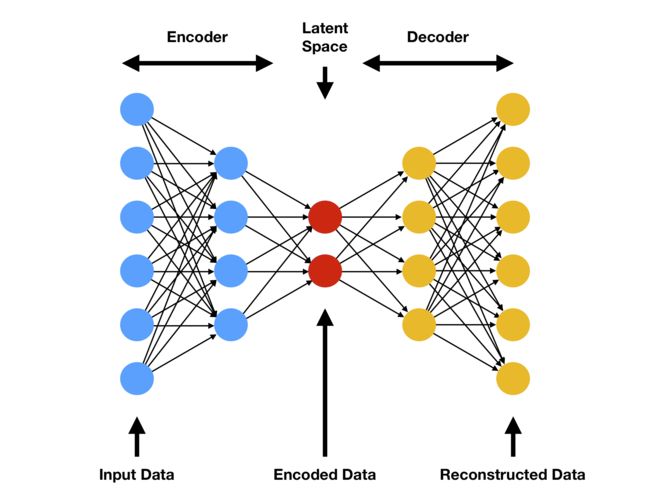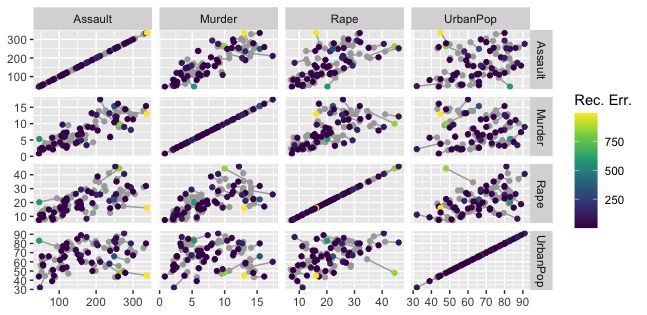auoteencoder是深度学习的一类算法之一,由encoder, latent space和decoder组成(见下图)。更多知识分享请到 https://zouhua.top/。
packages
# Helper packages
library(dplyr) # for data manipulation
library(ggplot2) # for data visualization
# Modeling packages
library(h2o) # for fitting autoencoders
train data
mnist <- dslabs::read_mnist()
names(mnist)
initialize H2O
h2o.no_progress() # turn off progress bars
h2o.init(max_mem_size = "5g") # initialize H2O instance
H2O is not running yet, starting it now...
Note: In case of errors look at the following log files:
C:\Users\zouhu\AppData\Local\Temp\Rtmp4APVUM\file521043104b5e/h2o_zouhua_started_from_r.out
C:\Users\zouhu\AppData\Local\Temp\Rtmp4APVUM\file521021935c59/h2o_zouhua_started_from_r.err
java version "1.8.0_231"
Java(TM) SE Runtime Environment (build 1.8.0_231-b11)
Java HotSpot(TM) 64-Bit Server VM (build 25.231-b11, mixed mode)
Starting H2O JVM and connecting: . Connection successful!
R is connected to the H2O cluster:
H2O cluster uptime: 5 seconds 583 milliseconds
H2O cluster timezone: Asia/Shanghai
H2O data parsing timezone: UTC
H2O cluster version: 3.32.0.1
H2O cluster version age: 2 months and 30 days
H2O cluster name: H2O_started_from_R_zouhua_vrf494
H2O cluster total nodes: 1
H2O cluster total memory: 4.44 GB
H2O cluster total cores: 6
H2O cluster allowed cores: 6
H2O cluster healthy: TRUE
H2O Connection ip: localhost
H2O Connection port: 54321
H2O Connection proxy: NA
H2O Internal Security: FALSE
H2O API Extensions: Amazon S3, Algos, AutoML, Core V3, TargetEncoder, Core V4
R Version: R version 4.0.2 (2020-06-22)
Comparing PCA to an autoencoder
# Convert mnist features to an h2o input data set
features <- as.h2o(mnist$train$images)
# Train an autoencoder
ae1 <- h2o.deeplearning(
x = seq_along(features),
training_frame = features,
autoencoder = TRUE,
hidden = 2,
activation = 'Tanh',
sparse = TRUE
)
# Extract the deep features
ae1_codings <- h2o.deepfeatures(ae1, features, layer = 1)
ae1_codings
Stacked autoencoders
# Hyperparameter search grid
hyper_grid <- list(hidden = list(
c(50),
c(100),
c(300, 100, 300),
c(100, 50, 100),
c(250, 100, 50, 100, 250)
))
# Execute grid search
ae_grid <- h2o.grid(
algorithm = 'deeplearning',
x = seq_along(features),
training_frame = features,
grid_id = 'autoencoder_grid',
autoencoder = TRUE,
activation = 'Tanh',
hyper_params = hyper_grid,
sparse = TRUE,
ignore_const_cols = FALSE,
seed = 123
)
# Print grid details
h2o.getGrid('autoencoder_grid', sort_by = 'mse', decreasing = FALSE)
visualization
# Get sampled test images
index <- sample(1:nrow(mnist$test$images), 4)
sampled_digits <- mnist$test$images[index, ]
colnames(sampled_digits) <- paste0("V", seq_len(ncol(sampled_digits)))
# Predict reconstructed pixel values
best_model_id <- ae_grid@model_ids[[1]]
best_model <- h2o.getModel(best_model_id)
reconstructed_digits <- predict(best_model, as.h2o(sampled_digits))
names(reconstructed_digits) <- paste0("V", seq_len(ncol(reconstructed_digits)))
combine <- rbind(sampled_digits, as.matrix(reconstructed_digits))
# Plot original versus reconstructed
par(mfrow = c(1, 3), mar=c(1, 1, 1, 1))
layout(matrix(seq_len(nrow(combine)), 4, 2, byrow = FALSE))
for(i in seq_len(nrow(combine))) {
image(matrix(combine[i, ], 28, 28)[, 28:1], xaxt="n", yaxt="n")
}
ANN2实现
Artificial Neural Networks package for R的优势
Easy to use interface - defining and training neural nets with a single function call!
Activation functions: tanh, sigmoid, relu, linear, ramp, step
Loss functions: log, squared, absolute, huber, pseudo-huber
Regularization: L1, L2
Optimizers: sgd, sgd w/ momentum, RMSprop, ADAM
Plotting functions for visualizing encodings, reconstructions and loss (training and validation)
Helper functions for predicting, reconstructing, encoding and decoding
Reading and writing the trained model from / to disk
Access to model parameters and low-level Rcpp module methods
- neuralnetwork() 神经网络
library(ANN2)
# Prepare test and train sets
random_idx <- sample(1:nrow(iris), size = 145)
X_train <- iris[random_idx, 1:4]
y_train <- iris[random_idx, 5]
X_test <- iris[setdiff(1:nrow(iris), random_idx), 1:4]
y_test <- iris[setdiff(1:nrow(iris), random_idx), 5]
# Train neural network on classification task
NN <- neuralnetwork(X = X_train,
y = y_train,
hidden.layers = c(5, 5),
optim.type = 'adam',
n.epochs = 5000)
# Predict the class for new data points
predict(NN, X_test)
# $predictions
# [1] "setosa" "setosa" "setosa" "versicolor" "versicolor"
#
# $probabilities
# class_setosa class_versicolor class_virginica
# [1,] 0.9998184126 0.0001814204 1.670401e-07
# [2,] 0.9998311154 0.0001687264 1.582390e-07
# [3,] 0.9998280223 0.0001718171 1.605735e-07
# [4,] 0.0001074780 0.9997372337 1.552883e-04
# [5,] 0.0001077757 0.9996626441 2.295802e-04
# Plot the training and validation loss
plot(NN)
- autoencoder() 自编码
# Prepare test and train sets
random_idx <- sample(1:nrow(USArrests), size = 45)
X_train <- USArrests[random_idx,]
X_test <- USArrests[setdiff(1:nrow(USArrests), random_idx),]
# Define and train autoencoder
AE <- autoencoder(X = X_train,
hidden.layers = c(10,3,10),
loss.type = 'pseudo-huber',
optim.type = 'adam',
n.epochs = 5000)
# Reconstruct test data
reconstruct(AE, X_test)
# $reconstructed
# Murder Assault UrbanPop Rape
# [1,] 8.547431 243.85898 75.60763 37.791746
# [2,] 12.972505 268.68226 65.40411 29.475545
# [3,] 2.107441 78.55883 67.75074 15.040075
# [4,] 2.085750 56.76030 55.32376 9.346483
# [5,] 12.936357 252.09209 56.24075 24.964715
#
# $anomaly_scores
# [1] 398.926431 247.238111 11.613522 0.134633 1029.806121
# Plot original points (grey) and reconstructions (colored) for training data
reconstruction_plot(AE, X_train)
Reference
Autoencoder
ANN2 tutorial
ANN2 github
参考文章如引起任何侵权问题,可以与我联系,谢谢。


